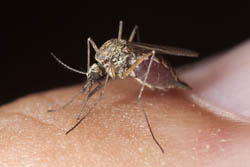New targets against pregnancy-associated malaria
Pregnant women are more susceptible to Plasmodium falciparum infections, and often with detrimental consequences for both them and their developing unborn children. Pregnancy-associated malaria (PAM) outcome is largely dependent on the adhesion of infected erythrocytes to placental chondroitin-4-sulfate (CSA). After multiple pregnancies, maternal antibodies against CSA-binding parasites emerge and block CSA-binding of placental Plasmodium isolates from different parts of the world. The EU-funded 'Structural analysis of the CSA binding interactions involved during pregnancy associated malaria' (PREMALSTRUCT) project wished to take advantage of this transcending immunity and develop a vaccine against CSA-binding parasites. For this purpose, it was important to decipher the molecular basis of the CSA binding to the parasite ligands in order to identify the reactive epitopes that could be used for vaccine development. Partners focused on VAR2CSA, a member of the P. falciparum erythrocyte membrane protein 1 (PfEMP1) family, and solved its three-dimensional (3D) structure. Characterisation of the CSA binding site revealed that several VAR2CSA domains were required for its formation. A recombinant, full-length VAR2CSA protein was used to produce monoclonal antibodies against the different Duffy binding-like (DBL) domains and it was shown that antibodies against the DBL3 domain inhibit the interaction between the full-length protein and decorin. Researchers also performed virtual screenings to identify compounds that mimic CSA and could be used to block the binding of the infected erythrocyte. Results showed that sulphate groups were central to the interaction, thereby providing solid clues about the structure of potential inhibitors. Furthermore, as a tool for drug testing, the consortium developed a mouse model of PAM and identified proteins present on the membrane of infected erythrocytes. These were utilised to express P. falciparum receptor binding domains, thereby creating a humanised mouse model for in vivo investigations of host–parasite interactions. Work carried out by the PREMALSTRUCT project provided significant information on the functional and immunological characteristics of protein variants expressed by placental malaria. The knowledge produced is essential for the development of a vaccine or other therapeutic interventions against this form of malaria.







